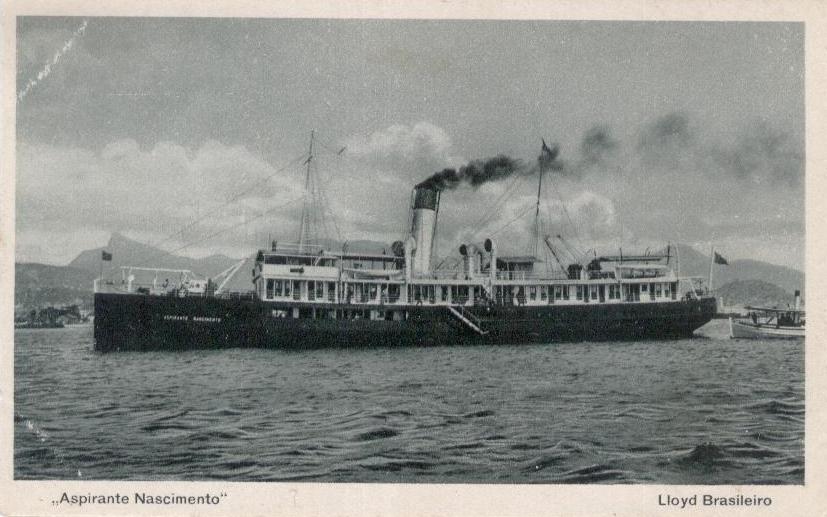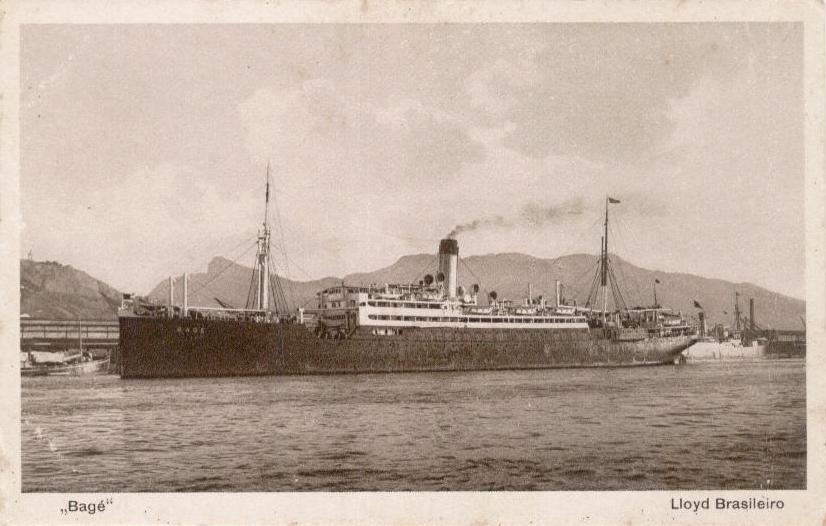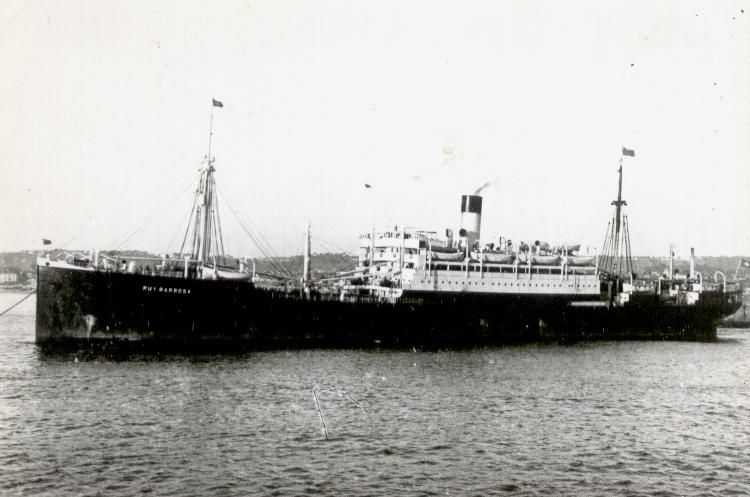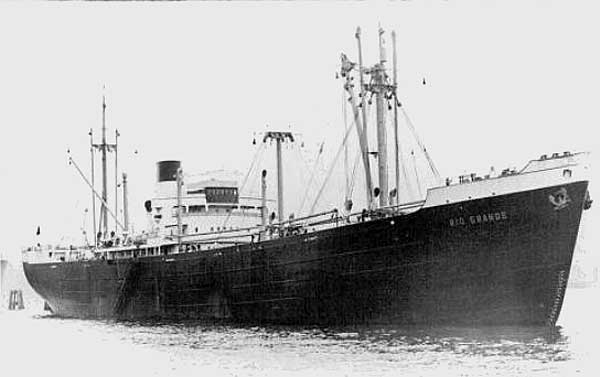Lloyd Brasileiro on:
[Wikipedia]
[Google]
[Amazon]
Companhia de Navegação Lloyd Brasileiro ( en, Navigation Company Lloyd Brasileiro), usually just called Lloyd Brasileiro, Lóide or Lloydbrás, was a Brazilian shipping company founded on 19 February 1894. It became the only major shipping company in South America, in particular by taking over German ships confiscated in 1917 by Brazil's entry into the

 With the
With the
 When Brazil joined the war on the side of the Triple Entente in 1917, the 45 ships of the Central Powers were seized in Brazilian ports and used as merchant ships by Lloyd Brasileiro. Thus, the largest ship of the Brazilian merchant navy and shipping company became the Hapag steamer ''Blücher'' of 12,334 GRT renamed as ''Leopoldina'', which, however, was placed at the disposal of France in 1918 and from 1921 was used by the
When Brazil joined the war on the side of the Triple Entente in 1917, the 45 ships of the Central Powers were seized in Brazilian ports and used as merchant ships by Lloyd Brasileiro. Thus, the largest ship of the Brazilian merchant navy and shipping company became the Hapag steamer ''Blücher'' of 12,334 GRT renamed as ''Leopoldina'', which, however, was placed at the disposal of France in 1918 and from 1921 was used by the
 By 1922, three more formerly German ships in the service of Lloyd Brasileiro had been lost. The most serious accident was the capsizing of the ''Avare'' (former ''Sierra Salvada'') on 16 January 1922, while undocking in the port of Hamburg, in which 39 men, including 26 Brazilian seamen, lost their lives.
In the 1920s, the majority of the formerly German ships were also gradually formally transferred to the state-owned shipping company (33 ships, 165,133 GRT). The shipping company was again in a privatization phase after the war, but this came to an end during the great shipping crisis. In 1931, the Lloyd Brasileiro was one of the 50 largest shipping companies in the world and by far the largest shipping company in South America, with 73 ships of 271,000 GRT combined. However, the company bought only a few used ships and received hardly any newbuildings. In 1939, the company's most modern ships were five small motor freighters of 2,900 GRT of the Bandeirante type, built in the Netherlands.
By 1922, three more formerly German ships in the service of Lloyd Brasileiro had been lost. The most serious accident was the capsizing of the ''Avare'' (former ''Sierra Salvada'') on 16 January 1922, while undocking in the port of Hamburg, in which 39 men, including 26 Brazilian seamen, lost their lives.
In the 1920s, the majority of the formerly German ships were also gradually formally transferred to the state-owned shipping company (33 ships, 165,133 GRT). The shipping company was again in a privatization phase after the war, but this came to an end during the great shipping crisis. In 1931, the Lloyd Brasileiro was one of the 50 largest shipping companies in the world and by far the largest shipping company in South America, with 73 ships of 271,000 GRT combined. However, the company bought only a few used ships and received hardly any newbuildings. In 1939, the company's most modern ships were five small motor freighters of 2,900 GRT of the Bandeirante type, built in the Netherlands.
 During World War II, 30 Brazilian merchant ships were sunk by German U-boats, 17 of which belonged to Lloyd Brasileiro. The first occurred on 15 February 1942, when U-432 sank the 5,152 GRT ''Buarque'' of Lloyd, purchased from the United States in 1940, off the U.S. coast.
When Brazil declared war on Germany on 22 August 1942, 17 ships had been sunk in the meantime and it happened after the sinking of the ''Annibal Benévolo'' of the LB, ''Araraquara'', ''Baependy'' also of the LB, ''Arará'', ''Itagiba'' and ''Jacyra'' within four days by U-507 under corvette captain Harro Schacht without warning off the Brazilian coast. A total of 607 people died in the first three sinkings, including 270 on the ''Baependy'' and 150 on the ''Anníbal Benévolo''.
During World War II, 30 Brazilian merchant ships were sunk by German U-boats, 17 of which belonged to Lloyd Brasileiro. The first occurred on 15 February 1942, when U-432 sank the 5,152 GRT ''Buarque'' of Lloyd, purchased from the United States in 1940, off the U.S. coast.
When Brazil declared war on Germany on 22 August 1942, 17 ships had been sunk in the meantime and it happened after the sinking of the ''Annibal Benévolo'' of the LB, ''Araraquara'', ''Baependy'' also of the LB, ''Arará'', ''Itagiba'' and ''Jacyra'' within four days by U-507 under corvette captain Harro Schacht without warning off the Brazilian coast. A total of 607 people died in the first three sinkings, including 270 on the ''Baependy'' and 150 on the ''Anníbal Benévolo''.
LLOYD foi extinto através da Medida Provisória nº 1.592-5/98
on JusBrasil.com.br, 27 Jun 2022
Eight Brazilian steamers sunk by German U-boats
Navios e Portos website
{{Portalbar, Brazil, Companies, Transport Buildings and structures in Rio de Janeiro (city) Transatlantic shipping companies Companies based in Rio de Janeiro (state) Transport companies established in 1894 Transport companies disestablished in 1998 Defunct shipping companies of Brazil Military history of Brazil
First World War
World War I (28 July 1914 11 November 1918), often abbreviated as WWI, was one of the deadliest global conflicts in history. Belligerents included much of Europe, the Russian Empire, the United States, and the Ottoman Empire, with fightin ...
. In 1931, Lloyd Brasileiro was among the 50 largest shipping companies in the world, owning 73 ships of 271,000 GRT combined.
The company was dissolved in October 1997 during the government of president Fernando Henrique Cardoso.
History

 With the
With the independence of Brazil
The Independence of Brazil comprised a series of political and military events that led to the independence of the Kingdom of Brazil from the United Kingdom of Portugal, Brazil and the Algarves as the Brazilian Empire. Most of the events occurre ...
, the naval sector gradually restructured itself to cope with the growing demand for means of locomotion of cargo and passengers by river and sea. Brazilian admiral Artur Silveira da Mota (1843–1914) attempted to establish a Brazilian overseas shipping company beginning in 1886. This was to operate two steamship
A steamship, often referred to as a steamer, is a type of steam-powered vessel, typically ocean-faring and seaworthy, that is propelled by one or more steam engines that typically move (turn) propellers or paddlewheels. The first steamships ...
lines to Europe (northern Europe to Hamburg
(male), (female) en, Hamburger(s),
Hamburgian(s)
, timezone1 = Central (CET)
, utc_offset1 = +1
, timezone1_DST = Central (CEST)
, utc_offset1_DST = +2
, postal ...
and to the Mediterranean) and actively seek to support desirable immigration to Brazil. The ensuing unrest delayed the implementation of this plan. The company was founded in February 1894 with the federal government of Brazil as the main owner, and to this end the existing shipping companies ''Empreza Transatlântica Brasileira'', ''Companhia Brasileira de Navegação a Vapor'' and the ''Companhia Nacional de Navegação a Vapor'' merged with the smaller shipping companies ''Companhia Progresso Marítimo'', ''Companhia de Navegação da Estrada de Ferro Espírito Santo a Caravelas'', to which were added in 1891 the three smaller shipping companies ''Companhia Bahiana de Navegação'', ''Companhia Paraense de Navegação'' and the ''Companhia Brasileira de Estradas de Ferro e Navegação''.
In fact, the main business was Brazilian coastal traffic, including traffic in the Amazon basin
The Amazon basin is the part of South America drained by the Amazon River and its tributaries. The Amazon drainage basin covers an area of about , or about 35.5 percent of the South American continent. It is located in the countries of Bolivi ...
. However, commercial success failed to materialize. In 1906, a plan emerged to order 18 newbuildings in Britain and to purchase a number of used ships. The implementation of this plan and the establishment of lines to New York
New York most commonly refers to:
* New York City, the most populous city in the United States, located in the state of New York
* New York (state), a state in the northeastern United States
New York may also refer to:
Film and television
* '' ...
and, in 1910, to Portugal and then to Great Britain and Germany did not bring the economic profits and led to the complete takeover of the company by the state before World War I.
The company's largest ships in 1914 were the British-built ''Ceará'' (1907, 3324 GRT), ''Pará'' (1907, 3351 GRT), ''São Paulo'' (1907, 3583 GRT), ''Rio de Janeiro'' (1908, 3583 GRT), ''Bahia'' (1910, 3401 GRT), and ''Minas Gerais'' (1910, 3540 GRT), small passenger steamers with refrigerated holds for transporting agricultural goods on outbound voyages to Europe or the United States. The newbuildings were joined in 1911 by the freighters ''Purus'' (1900, 3822 GRT), ''Tocantins'' (1901, 3837 GRT) and ''Tapajós'' (1902, 3774 GRT), acquired from the British-Brazilian Buarque Line.
In addition to these nine ships over 3,000 GRT, there were four steamers over 2,000 GRT and 22 steamers of over 1,000 GRT. Among these were the steamers built for the Cia. de Nav. Cruzeiro do Sul, Santos. Hamburg Süd
Hamburg Südamerikanische Dampfschifffahrts-Gesellschaft A/S & Co KG, widely known as Hamburg Süd, is a German container shipping company. Founded in 1871, Hamburg Süd is among the market leaders in the North–South trade. It also serves a ...
and Hapag
The Hamburg-Amerikanische Packetfahrt-Aktien-Gesellschaft (HAPAG), known in English as the Hamburg America Line, was a transatlantic shipping enterprise established in Hamburg, in 1847. Among those involved in its development were prominent citi ...
had founded this company in 1905 for the coastal service between Rio de Janeiro
Rio de Janeiro ( , , ; literally 'River of January'), or simply Rio, is the capital of the state of the same name, Brazil's third-most populous state, and the second-most populous city in Brazil, after São Paulo. Listed by the GaWC as a b ...
and Buenos Aires
Buenos Aires ( or ; ), officially the Autonomous City of Buenos Aires ( es, link=no, Ciudad Autónoma de Buenos Aires), is the capital and primate city of Argentina. The city is located on the western shore of the Río de la Plata, on South ...
and had five ships (''Saturno'', ''Orion'', ''Jupiter'' and ''Sirio'' of 1,800 to 1,900 GRT and for the Rio Grande do Sul
Rio Grande do Sul (, , ; "Great River of the South") is a Federative units of Brazil, state in the South Region, Brazil, southern region of Brazil. It is the Federative_units_of_Brazil#List, fifth-most-populous state and the List of Brazilian st ...
–Porto Alegre
Porto Alegre (, , Brazilian ; ) is the capital and largest city of the Brazilian state of Rio Grande do Sul. Its population of 1,488,252 inhabitants (2020) makes it the List of largest cities in Brazil, twelfth most populous city in the country ...
service the ''Venus'' of 966 GRT) built in Germany. These ships all entered the service of Lloyd Brasileiro between 1908 and 1916 after the German holdings were abandoned.
World War I
The outbreak of World War I forced the company to shorten its European line and then take it into the Mediterranean. This change was also abandoned after Italy entered the war, especially as theCentral Powers
The Central Powers, also known as the Central Empires,german: Mittelmächte; hu, Központi hatalmak; tr, İttifak Devletleri / ; bg, Централни сили, translit=Tsentralni sili was one of the two main coalitions that fought in ...
stepped up their submarine warfare
Submarine warfare is one of the four divisions of underwater warfare, the others being anti-submarine warfare, mine warfare and mine countermeasures.
Submarine warfare consists primarily of diesel and nuclear submarines using torpedoes, missi ...
.
Brazil initially tacitly tolerated the use of some uninhabited islands off its coast by the belligerent powers. British warships also entered Brazilian ports relatively frequently. The Germans supplied their merchant ships, especially their small cruisers ''Dresden'' and ''Karlsruhe''. The landing of more than 400 prisoners of the ''Karlsruhe'' by a steamer of the Hamburg Süd in Belém
Belém (; Portuguese for Bethlehem; initially called Nossa Senhora de Belém do Grão-Pará, in English Our Lady of Bethlehem of Great Pará) often called Belém of Pará, is a Brazilian city, capital and largest city of the state of Pará in t ...
in the fall of 1914 led to the indication to the Germans that further support of their naval war would not be tolerated. The more than 40 German merchant ships in Brazilian ports did not subsequently conduct any support operations, especially since German warships did not operate off the Brazilian coast after the loss of the ''Karlsruhe'' and the East Asia Squadron
The German East Asia Squadron (german: Kreuzergeschwader / Ostasiengeschwader) was an Imperial German Navy cruiser Squadron (naval), squadron which operated mainly in the Pacific Ocean between the mid-1890s until 1914, when it was destroyed at th ...
until 1916. On 22 May 1917, the old steamer ''Lapa'' (former ''Sparta'', 1,366 GRT, 1872) of Lloyd Brasileiro, with a cargo of coffee bound for Marseilles
Marseille ( , , ; also spelled in English as Marseilles; oc, Marselha ) is the prefecture of the French department of Bouches-du-Rhône and capital of the Provence-Alpes-Côte d'Azur region. Situated in the camargue region of southern Franc ...
, was stopped off Gibraltar by the German submarine SM U-47 and became the fourth Brazilian ship to be sunk.
 When Brazil joined the war on the side of the Triple Entente in 1917, the 45 ships of the Central Powers were seized in Brazilian ports and used as merchant ships by Lloyd Brasileiro. Thus, the largest ship of the Brazilian merchant navy and shipping company became the Hapag steamer ''Blücher'' of 12,334 GRT renamed as ''Leopoldina'', which, however, was placed at the disposal of France in 1918 and from 1921 was used by the
When Brazil joined the war on the side of the Triple Entente in 1917, the 45 ships of the Central Powers were seized in Brazilian ports and used as merchant ships by Lloyd Brasileiro. Thus, the largest ship of the Brazilian merchant navy and shipping company became the Hapag steamer ''Blücher'' of 12,334 GRT renamed as ''Leopoldina'', which, however, was placed at the disposal of France in 1918 and from 1921 was used by the Compagnie Générale Transatlantique
The Compagnie Générale Transatlantique (CGT, and commonly named "Transat"), typically known overseas as the French Line, was a French shipping company. Established in 1855 by the Péreire brothers, brothers Émile and Issac Péreire under the ...
in service to the United States. In March 1923, the ship was sold to CGT and renamed ''Suffren''. In the service of the shipping company as the largest ship remained the ''Bahia Laura'' of Hamburg-Süd as ''Caxias'', then ''Ruy Barbosa'', of 9,790 GRT.
Operated by Lloyd Brasileiro, three steamers were lost to German U-boats during the First World War. They were:
*''Macao'', former ''Palatia'' of Hapa; 3,558 BRT, built 1912, whose sinking on 18 October 1917 finally triggered a state of war.
*''Acary'', former ''Ebernburg'' of DDG Hansa; 4,275 BRT, built 1905, sunk on 3 November 1917.
*''Maceió'', former ''Santa Anna'' of HSDG; 3.739 BRT, Bj. 1910, sunk on 2 August 1918.
Interwar period
 By 1922, three more formerly German ships in the service of Lloyd Brasileiro had been lost. The most serious accident was the capsizing of the ''Avare'' (former ''Sierra Salvada'') on 16 January 1922, while undocking in the port of Hamburg, in which 39 men, including 26 Brazilian seamen, lost their lives.
In the 1920s, the majority of the formerly German ships were also gradually formally transferred to the state-owned shipping company (33 ships, 165,133 GRT). The shipping company was again in a privatization phase after the war, but this came to an end during the great shipping crisis. In 1931, the Lloyd Brasileiro was one of the 50 largest shipping companies in the world and by far the largest shipping company in South America, with 73 ships of 271,000 GRT combined. However, the company bought only a few used ships and received hardly any newbuildings. In 1939, the company's most modern ships were five small motor freighters of 2,900 GRT of the Bandeirante type, built in the Netherlands.
By 1922, three more formerly German ships in the service of Lloyd Brasileiro had been lost. The most serious accident was the capsizing of the ''Avare'' (former ''Sierra Salvada'') on 16 January 1922, while undocking in the port of Hamburg, in which 39 men, including 26 Brazilian seamen, lost their lives.
In the 1920s, the majority of the formerly German ships were also gradually formally transferred to the state-owned shipping company (33 ships, 165,133 GRT). The shipping company was again in a privatization phase after the war, but this came to an end during the great shipping crisis. In 1931, the Lloyd Brasileiro was one of the 50 largest shipping companies in the world and by far the largest shipping company in South America, with 73 ships of 271,000 GRT combined. However, the company bought only a few used ships and received hardly any newbuildings. In 1939, the company's most modern ships were five small motor freighters of 2,900 GRT of the Bandeirante type, built in the Netherlands.
World War II
During World War II, Lloyd Brasileiro again received a large number of ships seized by the Brazilian government, the majority of which were Italian and Danish. The German share was small, as a large number of ships attempted to reach home even after the outbreak of war, some of them only after the conquest of France. Some German ships were also sold to Brazil to enable others to make supply runs to German warships. Thus Lloyd Brasileiro received the modern 6,000 GRT ''Montevideo'' of Hamburg-Süd, whose sister ship ''Porto Alegre'' left Santos 14 days after the outbreak of war and was able to break through to Hamburg. The other sister ship ''Rio Grande'' did not leave Rio Grande do Sul until October 1940, supplying the auxiliary cruiser ''Thor'' and taking its prisoners to France, and became one of the most successful German blockade runners. Beginning in 1940, the NDL Brasileiro fleet was strengthened by over 20 purchases from the United States. During World War II, 30 Brazilian merchant ships were sunk by German U-boats, 17 of which belonged to Lloyd Brasileiro. The first occurred on 15 February 1942, when U-432 sank the 5,152 GRT ''Buarque'' of Lloyd, purchased from the United States in 1940, off the U.S. coast.
When Brazil declared war on Germany on 22 August 1942, 17 ships had been sunk in the meantime and it happened after the sinking of the ''Annibal Benévolo'' of the LB, ''Araraquara'', ''Baependy'' also of the LB, ''Arará'', ''Itagiba'' and ''Jacyra'' within four days by U-507 under corvette captain Harro Schacht without warning off the Brazilian coast. A total of 607 people died in the first three sinkings, including 270 on the ''Baependy'' and 150 on the ''Anníbal Benévolo''.
During World War II, 30 Brazilian merchant ships were sunk by German U-boats, 17 of which belonged to Lloyd Brasileiro. The first occurred on 15 February 1942, when U-432 sank the 5,152 GRT ''Buarque'' of Lloyd, purchased from the United States in 1940, off the U.S. coast.
When Brazil declared war on Germany on 22 August 1942, 17 ships had been sunk in the meantime and it happened after the sinking of the ''Annibal Benévolo'' of the LB, ''Araraquara'', ''Baependy'' also of the LB, ''Arará'', ''Itagiba'' and ''Jacyra'' within four days by U-507 under corvette captain Harro Schacht without warning off the Brazilian coast. A total of 607 people died in the first three sinkings, including 270 on the ''Baependy'' and 150 on the ''Anníbal Benévolo''.
Post-war
Although the company, unlike many other shipping companies in the post-war period with high shipbuilding prices, did not initially have any new ships built and only commissioned the purchase of 22 new general cargo ships between 1958 and 1967, it nevertheless fell into a financial crisis in the 1960s. A privatization contemplated in 1967 did not materialize. After an economic high in the 1970s, Lloyd Brasileiro again fell into increasing financial distress due to poor freight rates in the early 1980s and heavy debt caused by the need to build new container ships in the second half of that decade.Dissolution
In the early 1990s, the company laid up a large part of its fleet and later ceased operations for good, despite promised rescue efforts by the government. From the end of 1995 until decisions by president Fernando Henrique Cardoso in late 1997 and 5 March 1998, respectively, the company wasliquidated
Liquidation is the process in accounting by which a company is brought to an end in Canada, United Kingdom, United States, Ireland, Australia, New Zealand, Italy, and many other countries. The assets and property of the company are redistrib ...
.on JusBrasil.com.br, 27 Jun 2022
See also
*Arsenal de Marinha do Rio de Janeiro
The Arsenal de Marinha do Rio de Janeiro (AMRJ) is a military organization of the Brazilian Navy. It is located in Ilha das Cobras, at the Guanabara Bay, in the city of Rio de Janeiro. The Arsenal is the main maintenance center and naval base o ...
*Brazil during World War I
During World War I (1914–1918), Brazil initially adopted a neutral position, in accordance with the Hague Convention, in an attempt to maintain the markets for its export products, mainly coffee, latex and industrial manufactured items. Howev ...
References
;Notes ;Bibliography * *External links
Eight Brazilian steamers sunk by German U-boats
Navios e Portos website
{{Portalbar, Brazil, Companies, Transport Buildings and structures in Rio de Janeiro (city) Transatlantic shipping companies Companies based in Rio de Janeiro (state) Transport companies established in 1894 Transport companies disestablished in 1998 Defunct shipping companies of Brazil Military history of Brazil